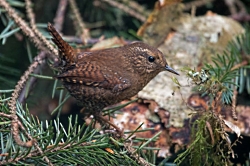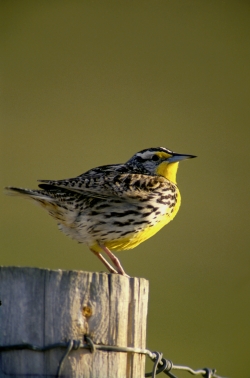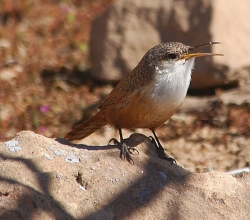
Courtesy US FWS
Peter Pearshall, Photographer
A recent snowshoe slog with friends in a nearby canyon brought us face to face with a glorious panel of 30 foot ice colonnades running down quartzite cliffs. We stood in awe of their crystalline beauty. Near the ice wall, small birds were flitting in and out of vertical crevices. I began counting- a dozen or more. There is only one bird in mid-winter that could fit the bill, a canyon wren. Possibly my favorite on the long list of wren species for their stunning beauty, and unique, descending melody to match their vertical realm, to sooth my nerves as I climb in their domain.
Never before had I seen more than a pair, usually solos. This was entirely new and totally unexpected, to have such numbers of mature wrens occupying the same space. I’ve since searched the literature and found nothing describing such behavior.
Moving on to another near favorite, the winter, or Pacific wren, is always a treat on winter outings. These smallest of the wren family remind me of feathered mice. They spend much of their time in thick brush or tree roots near or in the ground. Like all wrens, they are grand vocalists who release a rapid, lengthy string of phrases. Like all wrens, Pacific’s are very high energy in constant motion. They emit a tiny “chit” note when alarmed, similar to that of a ruby crowned kinglet, but unlike kinglets, very secretive darting in and out of their hideaways. I may have been the first to report them nesting in Cache Valley some 20 years ago. Now they populate most of our watered canyons in the Bear River Range.
Moving out to the valley wetlands, there are usually a few marsh wrens who overwinter. These nervous chatterers will build a spectacular conical nest of cattails and bulrush lined with cattail down come spring. It’s the male who performs the duty, actually building several to confuse predators and attract a female. She will inspect his architectural abilities, and if pleased, receive his seed, then insult him by dismantling a nest and rebuilding it to her liking.
I must travel down state to the St. George Mojave desert to visit another rival wren for the top spot. The cactus wren has a long rolling unmistakable muffled chatter. They are our largest wren species and no less nervous than the others. They too have an unusual nesting behavior, which involves a very prickly plant- the cholla. Their nest reminds me of the marsh wrens, only made of very different materials as cattail and bulrush are hard to come by where they occupy. Similar to the marsh wren, the male builds multiple “dummy nests” which he will continue, even after the female is sitting on the nest- expending nervous energy I recon!
I must apologize for two others as I’m out of space- rock wrens and the “jenny” or house wren- definitely worthy of note.
Happy Valentines Day to all wren lovers and others!
Jack Greene for Bridgerland Audubon- and we are Wild About Utah!
Credits:
Images: Courtesy US FWS, Peter Pearshall, Photographer
Audio: Contains Audio Courtesy and Copyright Kevin Colver
Text: Jack Greene, USU Sustainability & Bridgerland Audubon Society
Sources & Additional Reading:
Cane, James, Songs of the Western Meadowlark and Canyon Wren, Wild About Utah, Nov 5, 2009, https://wildaboututah.org/songs-of-the-western-meadowlark-and-canyon-wren/
Cane, James, Songs of the Western Meadowlark, Poorwill and Canyon Wren, Wild About Utah, May 3, 2012, https://wildaboututah.org/songs-of-the-western-meadowlark-poorwill-and-canyon-wren/
Wrens, Browse by Shape, All About Birds, The Cornell Lab of Ornithology, Cornell University, https://www.allaboutbirds.org/guide/browse/shape/Wrens


